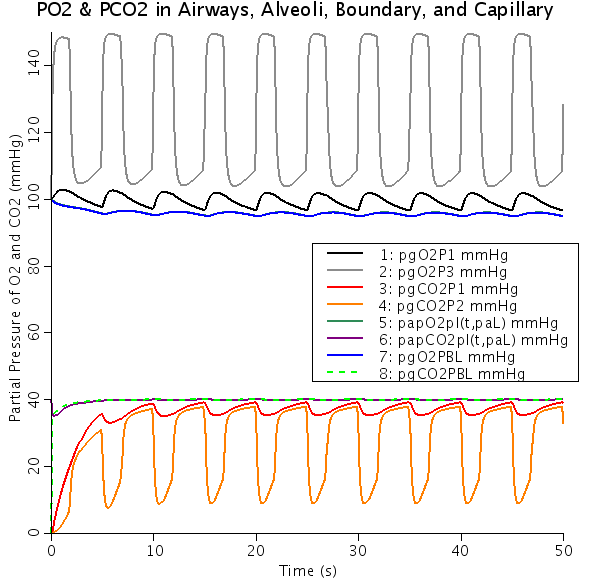Distributed model for O2-CO2 transport and exchange between a three compartment lung and the pulmonary circulation, modeled as a blood tissue exchange (BTEX) unit.
Description
Distributed model for O2-CO2 transport and exchange between a three
compartment lung and the pulmonary circulation, modeled as a blood
tissue exchange (BTEX) unit.
The lung model is composed of three serial compartments:
1) a low compliance compartment
- the oral/nasal cavity and the upper (cartilaginous) airways (UA)
2) a moderately compliant compartment
- the collapsible bronchial airways
3) a high compliance compartment
- the alveolar space
To ventilate the lung, positive pressure is applied at the airway opening
and is cycled on and off by a sequence of square waves. This pressure in
conjunction with the sequence of square waves creates bi-directional
airflow and a corresponding inflation and deflation of the lung. Either
respiratory rate or tidal volume can be controlled by altering the period
of the square wave or the pressure at the airway opening, respectively.
Oxygen and carbon dioxide move between adjacent lung compartments via
convective and diffusive mechanisms. Each compartment is well-mixed.
Respiratory gas exchange between the well-mixed alveolar space and the
plasma of the distributed BTEX unit occurs by diffusion. Inhaled partial
pressure of O2 and CO2 are user specified.
The pulmonary circulation model is composed of a blood-tissue exchange
(BTEX) unit. The BTEX unit is composed of a core of red blood cells (RBC)
surrounded by a layer of plasma. Respiratory gas exchange initially
occurs between the alveolar gas and the plasma which then exchanges
with the RBCs. O2 and CO2 bind instantaneously with hemoglobin.
HbO2 saturation depends explicitly on pH and pCO2. Similarly, HbCO2
saturation depends explicitly on pH and pO2. The user must specify
the incoming (pulmonary arterial) partial pressures of O2 and CO2.
The subscripts, "pl" and "rbc", refer to "plasma" and "red blood cells"
while the prefixes, "pa" and "pg", denote "pulmonary circulation" and
"pulmonary gas".
The lung model is stongly based on the three compartment model of gas
exchange developed by Jim Bassingthwaighte. The pulmonary circulation
model is solely based on the blood-tissue exchange (BTEX) model code
developed by Ranjan Dash, Assistant Professor, Compuational Bioengineering
Group, Medical College of Wisconsin. Modifications and unification of the
two codes were made by Joseph C. Anderson, National Simulations Resource,
Department of Bioengineering, University of Washington.

Figure: O2 and CO2 pressures at various points within the lung. P1: alveolus, P2: small bronchi, P3: oral cavity, pl: plasma (papO2pl is partial pressure of O2 in plasma), PBL: whole blood
Equations
The equations for this model may be viewed by running the JSim model applet and clicking on the Source tab at the bottom left of JSim's Run Time graphical user interface. The equations are written in JSim's Mathematical Modeling Language (MML). See the Introduction to MML and the MML Reference Manual. Additional documentation for MML can be found by using the search option at the Physiome home page.
- Download JSim model MML code (text):
- Download translated SBML version of model (if available):
- No SBML translation currently available.
- Information on SBML conversion in JSim
Carlson BE, Anderson JC, Raymond GM, Dash RK and Bassingthwaighte JB. Modeling oxygen and carbon dioxide transport and exchange using a closed loop circulatory system. Advances in Experimental Medicine and Biology: International Society on Oxygen Transport to Tissue:614:353-60, 2006. Dash RK and Bassingthwaighte JB.: Simultaneous blood-tissue exchange of oxygen, carbon dioxide, bicorbonate and hydrogen ion. Annals of Biomedical Engineering 34:1129-1148, 2006. Dash RK and Bassingthwaighte JB. Erratum to: Blood HbO2 and HbCO2 dissociation curves at varied O2, CO2, pH, 2,3-DPG and Temperature Levels. Ann Biomed Eng 38(4): 1683-1701, 2010.
Bassingthwaighte JBB, Raymond GM, Dash RK, Beard DA and Nolan M, The Pathway for Oxygen: Tutorial Modelling on Oxygen Transport from Air to Mitochondrion, International Society on Oxygen Transport to Tissue (ISOTT) 2014, in press.
Please cite https://www.imagwiki.nibib.nih.gov/physiome in any publication for which this software is used and send one reprint to the address given below:
The National Simulation Resource, Director J. B. Bassingthwaighte, Department of Bioengineering, University of Washington, Seattle WA 98195-5061.
Model development and archiving support at https://www.imagwiki.nibib.nih.gov/physiome provided by the following grants: NIH U01HL122199 Analyzing the Cardiac Power Grid, 09/15/2015 - 05/31/2020, NIH/NIBIB BE08407 Software Integration, JSim and SBW 6/1/09-5/31/13; NIH/NHLBI T15 HL88516-01 Modeling for Heart, Lung and Blood: From Cell to Organ, 4/1/07-3/31/11; NSF BES-0506477 Adaptive Multi-Scale Model Simulation, 8/15/05-7/31/08; NIH/NHLBI R01 HL073598 Core 3: 3D Imaging and Computer Modeling of the Respiratory Tract, 9/1/04-8/31/09; as well as prior support from NIH/NCRR P41 RR01243 Simulation Resource in Circulatory Mass Transport and Exchange, 12/1/1980-11/30/01 and NIH/NIBIB R01 EB001973 JSim: A Simulation Analysis Platform, 3/1/02-2/28/07.

